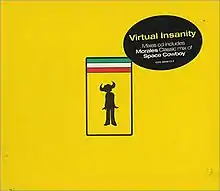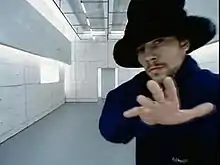Virtual Insanity
"Virtual Insanity" is a song by British funk band Jamiroquai. It was released as the second single from their third studio album, Travelling Without Moving (1996), on 19 August 1996. It interpolates parts of Jocelyn Brown's post-disco hit "Somebody Else's Guy" (1984). The song's award-winning music video was released in September 1996. "Virtual Insanity" was a number-one hit in Iceland and reached number three on the UK Singles Chart. As well as becoming a top-ten hit in Finland, Ireland, and Italy, the song also climbed to number 38 on the Billboard Modern Rock Tracks chart upon the single's release in the United States in 1997. The sight of an underground town in Sapporo provided inspiration to this song.[2]
| "Virtual Insanity" | ||||
|---|---|---|---|---|
 | ||||
| Single by Jamiroquai | ||||
| from the album Travelling Without Moving | ||||
| B-side |
| |||
| Released | 19 August 1996[1] | |||
| Genre | Jazz-funk, acid jazz | |||
| Length |
| |||
| Label | Sony Soho Square | |||
| Songwriter(s) | ||||
| Producer(s) |
| |||
| Jamiroquai singles chronology | ||||
| ||||
| Audio sample | ||||
| ||||
| Music video | ||||
| "Virtual Insanity" on YouTube | ||||
Single information
The first B-side of the single is the song "Do U Know Where You're Coming From", in collaboration with M-Beat. It was released as a single earlier in 1996. The second B-side of the single is "Bullet". The song starts with a 3-second percussion intro, and switches into a longer, very claustrophobic introduction. During this part, very faint vocals can be heard in the background, while the melody progresses.
In the beginning of the song, a sound that is sampled from the film Alien appears. It is the sound sequence when the S.O.S. signal appears on the screens of the spaceship Nostromo at the start of the film.
Critical reception
The song received favourable reviews from music critics. Aberdeen Press and Journal described it as "cool if lyrically trite".[3] Justin Chadwick from Albumism wrote that the "midtempo, piano-driven groove" finds the singer "lamenting the proliferation of technology at the expense of human connection and preservation of our planet", as best evidenced in the chorus with lines such as, "Always seem to, be governed by this love we have / For useless, twisting, our new technology / Oh, now there is no sound—for we all live underground". He added, "While the song itself reflected Jamiroquai's more mature and polished sound at the time, it was the accompanying video unveiled the following month that became the band's transformative, watershed moment."[4] Liverpool Echo noted, "If you stop dancing, and listen to the lyrics, you see a whole new side to singer Jay Kay."[5] Ted Kessler from NME called it a "bittersweet" gem and a "fine" single.[6] Aidin Viziri from Salon stated that the singer "keeps the party alive with unbridled enthusiasm", "exploring the chaos of modern life".[7]
Music video
"Virtual Insanity" is Jamiroquai's best known music video. It was directed by English filmmaker, director, and screenwriter Jonathan Glazer. At the 1997 MTV Video Music Awards in September 1997, it earned 10 nominations, winning four awards, including "Breakthrough Video" and the "Best Video of the Year." In 2006, it was voted 9th by MTV viewers in a poll on music videos that 'broke the rules.' The single was released in the U.S. in 1997. At the 1997 MTV Video Music Awards, Jamiroquai performed the song, recreating the famous floor moving concept with two moving walkways on the stage floor, going in different directions, for Jay Kay to use to dance on.[8]
Content

The video consists mainly of Jamiroquai's singer, Jay Kay, dancing and performing the song in a bright white room with a grey floor. Throughout the video, there are several combinations of couches and easy chair, which are the only pieces of furniture in the room. The video earned recognition from critics for its special effects: the floor appears to move while the rest of the room stays still. At some points, the camera tilts up or down to show the floor or ceiling for a few seconds, and when it returns to the central position, the scene has completely changed. Other scenes show a crow flying across the room, a cockroach on the floor, the couches bleeding and the other members of Jamiroquai in a corridor being blown away by wind. This became the second video released by Jamiroquai to be successfully done in one complete, albeit composited, shot; "Space Cowboy" was the first. In a short making-of documentary, director Jonathan Glazer describes how the walls move on a stationary grey floor with no detail, to give the illusion that objects on the floor are moving. In several shots, chairs or couches are fixed to the walls so that they appear to be standing still, when in fact they are moving. In other shots chairs remain stationary on the floor, but the illusion is such that they appear to be moving.[9] The moving walls were not completely rigid and can be seen in some shots to wiggle slightly.
Accolades
| Year | Organization | Award | Result |
|---|---|---|---|
| 1997 | MTV Video Music Award | Video of the Year | Won |
| Best New Artist | Nominated | ||
| Breakthrough Video | Won | ||
| Best Direction (Directors: Jonathan Glazer) | Nominated | ||
| Best Choreography (Choreographers: Jason Kay) | Nominated | ||
| Best Visual Effects (Visual Effects: Jonathan Glazer and Sean Broughton) | Won | ||
| Best Art Direction (Art Director: John Bramble) | Nominated | ||
| Best Editing (Editor: Jonathan Glazer and John McManus) | Nominated | ||
| Best Cinematography (Cinematographer: Stephen Keith-Roach) | Won | ||
| International Viewer's Choice Award for MTV Europe | Nominated |
Track listing
UK CD No. 1 single (663613 2)
- "Virtual Insanity" – 4:04
- "Do U Know Where You're Coming From" (Original Mix) – 4:59
- "Bullet" – 4:19
- "Virtual Insanity" (Album Version) – 5:40
UK CD No. 2 single (663613 5)
- "Virtual Insanity" – 4:04
- "Space Cowboy" (Classic Radio) – 4:01
- "Emergency On Planet Earth" (London Rican Mix) – 7:10
- "Do U Know Where You're Coming From" – 4:59
US CD promo No. 1 (OSK 0857)
- "Virtual Insanity" (Peace of Mind Edit)
- "Virtual Insanity" (Radio Edit)
- "Virtual Insanity" (Album Version) – 5:40
- "Virtual Insanity" (Peace of Mind Mix)
US CD promo No. 2 (OSK 9857)
- "Virtual Insanity" (Radio Edit)
Cassette (663613 4)
- "Virtual Insanity" – 4:04
- "Virtual Insanity" (Album Version) – 5:40
- "Virtual Insanity" (Unreality Mix) – 3:54
Charts and certifications
Weekly charts
|
Year-end charts
Certifications
| ||||||||||||||||||||||||||||||||||||||||||||||||||||||||||||||||||||||
In popular culture
"Virtual Insanity" was parodied in the music video for Austin Mahone and Pitbull's "Mmm Yeah" in 2014, the FIDLAR video "40oz. on Repeat" in 2015, and in the Family Guy episode "Scammed Yankees". A cover remix version of "Virtual Insanity" is featured in the 2006 music video game Beatmania. In American comedy series Silicon Valley, the song is alluded to when the character Jack Barker has Jamiroquai perform a parody of the song entitled "Virtual Reality" as part of a release event for his company's new virtual reality venture.
In 2013, an animated parody of the music video was uploaded to YouTube. The video features Weather Report, a character from the Japanese manga series JoJo's Bizarre Adventure, rotoscoped onto the music video. In recent years, it has become popular among the series's fans.
In 2015, a video game based on the song's music video was released.[37]
References
- "Ultratop.be – Jamiroquai – Virtual Insanity" (in Dutch). Ultratip. Retrieved 25 June 2016.
- "Jamiroquai - Live at Tokyo dome on Youtube , November 18,1999". Youtube. Retrieved 6 April 2018.
- Aberdeen Press and Journal. 20 September 1996. p. 12. Retrieved 28 November 2020.
- Chadwick, Justin (7 September 2016). "Jamiroquai's 'Travelling Without Moving' Turns 20: Anniversary Retrospective". Albumism. Retrieved 16 November 2020.
- Liverpool Echo. 18 October 1996. p. 36. Retrieved 28 November 2020.
- Kessler, Ted. "JAMIROQUAI – Travelling Without Moving". NME. Retrieved 24 November 2020.
- Viziri, Aidin (17 January 1997). "Sharps and Flats". Salon. Retrieved 9 August 2020.
- "Beck, Jamiroquai big winners at MTV Music Awards". CNN, September 5, 1997
- Jonathan Glazer The Making of Jamiroquai's Virtual Insanity, YouTube, URL accessed 3 June 2018
- Ryan, Gavin (2011). Australia's Music Charts 1988-2010. Mt. Martha, VIC, Australia: Moonlight Publishing.
- "Ultratop.be – Jamiroquai – Virtual Insanity" (in French). Ultratop 50. Retrieved 25 June 2016.
- "Top RPM Singles: Issue 3288." RPM. Library and Archives Canada. Retrieved 11 October 2018.
- "Eurochart Hot 100 Singles" (PDF). Music & Media. Vol. 13 no. 37. 14 September 1996. p. 16. Retrieved 5 June 2020.
- "Jamiroquai: Virtual Insanity" (in Finnish). Musiikkituottajat – IFPI Finland. Retrieved 25 June 2016.
- "Lescharts.com – Jamiroquai – Virtual Insanity" (in French). Les classement single. Retrieved 25 June 2016.
- "Offiziellecharts.de – Jamiroquai – Virtual Insanity". GfK Entertainment Charts. Retrieved 25 June 2016.
- "Íslenski Listinn Topp 40 (03.10.1996 – 09.10.1996)". Dagblaðið Vísir (in Icelandic). 4 October 1996. p. 16. Retrieved 5 February 2018.
- "The Irish Charts – Search Results – Virtual Insanity". Irish Singles Chart. Retrieved 25 June 2016.
- "Top National Sellers" (PDF). Music & Media. Vol. 13 no. 37. 14 September 1996. p. 18. Retrieved 26 November 2019.
- "Official Scottish Singles Sales Chart Top 100". Official Charts Company. Retrieved 11 October 2018.
- "Swedishcharts.com – Jamiroquai – Virtual Insanity". Singles Top 100. Retrieved 25 June 2016.
- "Swisscharts.com – Jamiroquai – Virtual Insanity". Swiss Singles Chart. Retrieved 25 June 2016.
- "Official Singles Chart Top 100". Official Charts Company. Retrieved 25 June 2016.
- "Official R&B Singles Chart Top 40". Official Charts Company. Retrieved 11 October 2018.
- "Jamiroquai Chart History (Adult Pop Songs)". Billboard. Retrieved 25 June 2016.
- "Jamiroquai Chart History (Alternative Airplay)". Billboard. Retrieved 25 June 2016.
- "Jamiroquai Chart History (Dance Club Songs)". Billboard. Retrieved 25 June 2016.
- "Jamiroquai Chart History (Pop Songs)". Billboard. Retrieved 25 June 2016.
- "Jamiroquai Chart History (Japan Hot 100)". Billboard. Retrieved 5 June 2020.
- "Rapports annuels 1996" (in French). Ultratop. Retrieved 11 October 2018.
- "Year-End Sales Charts – Eurochart Hot 100 Singles 1996" (PDF). Music & Media. Vol. 13 no. 51/52. 21 December 1996. p. 12. Retrieved 5 June 2020.
- "Tops de L'année | Top Singles 1996" (in French). SNEP. Retrieved 17 January 2021.
- "Árslistinn 1996". Dagblaðið Vísir (in Icelandic). 2 January 1997. p. 25. Retrieved 30 May 2020.
- "Top 100 Singles 1996". Music Week. 18 January 1997. p. 25.
- "Italian single certifications – Jamiroquai – Virtual Insanity" (in Italian). Federazione Industria Musicale Italiana. Retrieved 30 September 2019. Select "2019" in the "Anno" drop-down menu. Select "Virtual Insanity" in the "Filtra" field. Select "Singoli online" under "Sezione".
- "British single certifications – Jamiroquai – Virtual Insanity". British Phonographic Industry. Retrieved 11 October 2018.
- Dean, Rob (13 May 2015). "Control virtual Jamiroquai in game based on the "Virtual Insanity" music video". The A.V. Club.